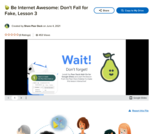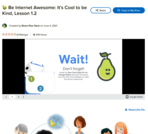
Unit 3 of Google’s digital safety curriculum is focused on teaching students to get real about privacy and security.
- Subject:
- Media and Communications
- Material Type:
- Unit of Study
- Provider:
- Date Added:
- 10/04/2023

Unit 3 of Google’s digital safety curriculum is focused on teaching students to get real about privacy and security.

Unit 4 of Google’s digital safety curriculum is focused on teaching students to learn and practice the power of online kindness

Unit 5 of Google’s digital safety curriculum is focused on teaching students to define and encourage Internet Brave behavior.

This resource is a Google Slides/Pear Deck lesson you can use in your classroom. Many details that raise "red flags" for adults can go overlooked by kids. Help them learn what they are, what to look for, and how to "trust their gut" when they encounter suspicious or possibly harmful emails, websites, and apps.

This resource is a Google Slides/Pear Deck lesson you can use in your classroom. Many details that raise "red flags" for adults can go overlooked by kids. Help them learn what they are, what to look for, and how to "trust their gut" when they encounter suspicious or possibly harmful emails, websites, and apps.

This resource is a Google Slides/Pear Deck lesson you can use in your classroom. Many details that raise "red flags" for adults can go overlooked by kids. Help them learn what they are, what to look for, and how to "trust their gut" when they encounter suspicious or possibly harmful emails, websites, and apps.

This resource is a Google Slides/Pear Deck lesson you can use in your classroom. Many details that raise "red flags" for adults can go overlooked by kids. Help them learn what they are, what to look for, and how to "trust their gut" when they encounter suspicious or possibly harmful emails, websites, and apps.

This resource is a Google Slides/Pear Deck lesson you can use in your classroom. Many details that raise "red flags" for adults can go overlooked by kids. Help them learn what they are, what to look for, and how to "trust their gut" when they encounter suspicious or possibly harmful emails, websites, and apps.

This resource is a Google Slides/Pear Deck lesson you can use in your classroom. Many details that raise "red flags" for adults can go overlooked by kids. Help them learn what they are, what to look for, and how to "trust their gut" when they encounter suspicious or possibly harmful emails, websites, and apps.

This resource is a Google Slides/Pear Deck lesson you can use in your classroom. Many details that raise "red flags" for adults can go overlooked by kids. Help them learn what they are, what to look for, and how to "trust their gut" when they encounter suspicious or possibly harmful emails, websites, and apps.

This resource is a Google Slides/Pear Deck lesson you can use in your classroom. Many details that raise "red flags" for adults can go overlooked by kids. Help them learn what they are, what to look for, and how to "trust their gut" when they encounter suspicious or possibly harmful emails, websites, and apps.

This resource is a Google Slides/Pear Deck lesson you can use in your classroom. The "golden rule" is just as important online as it is "IRL". The internet can be a truly great place to learn when comments, conversations, and content are positive. Help students see how to make choices that disempower bullying behaviour and create healthy, productive spaces to interact.

This resource is a Google Slides/Pear Deck lesson you can use in your classroom. The "golden rule" is just as important online as it is "IRL". The internet can be a truly great place to learn when comments, conversations, and content are positive. Help students see how to make choices that disempower bullying behaviour and create healthy, productive spaces to interact.

This resource is a Google Slides/Pear Deck lesson you can use in your classroom. The "golden rule" is just as important online as it is "IRL". The internet can be a truly great place to learn when comments, conversations, and content are positive. Help students see how to make choices that disempower bullying behaviour and create healthy, productive spaces to interact.

This resource is a Google Slides/Pear Deck lesson you can use in your classroom. The "golden rule" is just as important online as it is "IRL". The internet can be a truly great place to learn when comments, conversations, and content are positive. Help students see how to make choices that disempower bullying behaviour and create healthy, productive spaces to interact.

This resource is a Google Slides/Pear Deck lesson you can use in your classroom. The "golden rule" is just as important online as it is "IRL". The internet can be a truly great place to learn when comments, conversations, and content are positive. Help students see how to make choices that disempower bullying behaviour and create healthy, productive spaces to interact.

This resource is a Google Slides/Pear Deck lesson you can use in your classroom. The "golden rule" is just as important online as it is "IRL". The internet can be a truly great place to learn when comments, conversations, and content are positive. Help students see how to make choices that disempower bullying behaviour and create healthy, productive spaces to interact.

This resource is a Google Slides/Pear Deck lesson you can use in your classroom. Help your students understand that privacy is more than just what they choose to share or not share online. This lesson helps students understand what information should be private and safeguarded – and what they need to do to keep it that way.

This resource is a Google Slides/Pear Deck lesson you can use in your classroom. Help your students understand that privacy is more than just what they choose to share or not share online. This lesson helps students understand what information should be private and safeguarded – and what they need to do to keep it that way.

This resource is a Google Slides/Pear Deck lesson you can use in your classroom. Help your students understand that privacy is more than just what they choose to share or not share online. This lesson helps students understand what information should be private and safeguarded – and what they need to do to keep it that way.